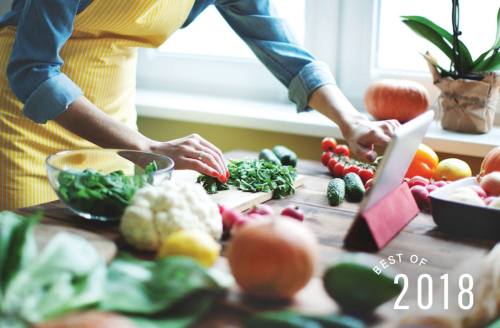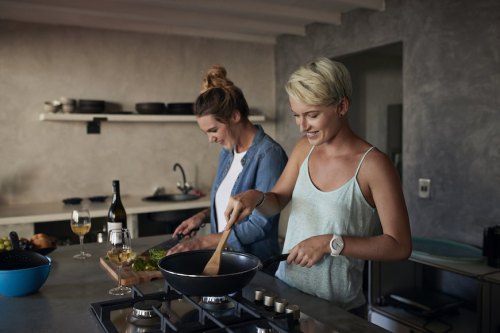Our editors independently select these products. Making a purchase through our links may earn Well+Good a commission
These are the top 10 healthy eating tips we learned in 2018
See a roundup of the top healthy eating tips editors at Well+Good learned in 2018 from doctors, registered dietitians, and nutritonists.

One of the benefits of interviewing wellness experts for a living and doing deep dives into questions that keep us up at night (Are potatoes healthy? Can you OD on adaptogens?) is that you learn a lot about healthy eating. It seems like a new food trend pops up every week—I think we can all agree that 2018 was the year CBD officially went mainstream—and it can be hard to know which ones are worth pursing and what’s more hype than healthy. MDs, dietitians, nutritionists, and health coaches help cut through the noise and tune into what’s really important.
To that end, compiled here are the most surprising, educational, and behavior-changing eatings tips Team Well+Good learned this year. Keep reading and prepare for your mind to be blown—and for your meal-prep routine to get a New Year’s makeover.

1. Eating moldy bread is nothing to freak out over.
Unlike those apples in your crisper that take weeks to go bad, bread has a relatively short shelf life. If you don’t eat it in time, you’re bound to see fuzzy green spots starting to sprout up—a sure sign to toss the loaf. But what if you bite into your sandwich before you see it? Terrifying, right? Before you freak out—don’t. Turns out, a little bit of mold just one time isn’t going to do much damage. The image of biting into a moldy slice, though? Let’s be honest, you may never get that out of your mind.
2. The way you brew your coffee affects how wired you’ll be.
You might already know that not all coffee beans are created equal. (If you can take a nap 20 minutes after downing your brew, chances are the beans are polluted.) But it turns out that how your coffee is prepared makes a difference, too. According to Bob Arnot, MD, an internal medicine doctor and author of The Coffee Lover’s Bible, brewing methods with higher levels of extraction get more caffeine and polyphenols out of your grind. Here’s what this means for your brewing habits: Pour-over methods will have a stronger effect than automatic drip, single-cup coffee makers, and French press.
3. Yes, avocados really are magical.
Avocados are the darling of the healthy food world; chances are your Instagram feed is full of ’em. Finding out if they’re really worth all the obsessive praise was the subject of Well+Good’s very first You Versus Food YouTube episode. “The avocado is known for its dual properties of having high fiber and also being a healthy fat,” registered dietitian Tracy Lockwood-Beckerman says in the video. “One avocado actually has 14 grams of fiber, and that’s 50 percent of what you need all day.” She also calls out that avocados also have lutein and zeaxanthin, which help protect your eyes from UV rays from technology. Fun fact, right?
4. There’s an inflammation-fighting superstar more powerful than turmeric
Turmeric often wins the (ahem) gold for combating inflammation, but one of Well+Good’s 2018 Wellness Trends celebrated a plant-based source even more powerful: moringa. Grown on trees in regions of Africa, South America, and India, the super green is typically ground up and used in powder form, and this year it surged in popularity, becoming the starring ingredient in everything from bottled juices and energy bars—and even your morning latte. What makes it so great? Moringa has twice the amount of protein, four times the calcium, six times the iron, and a whopping 48 times the amount of vitamin B2. Pretty cool, right?
5. No, the microwave doesn’t make your food less healthy.
The microwave isn’r exactly associated with nutritious eating. It doesn’t actually zap away your nutrients—but what goes inside it in the first place is typically less healthy than what’s being made on the stove. But in the past few years, healthier food has taken over the frozen food section—including heat-and-eat veggies. And as it turns out, speedy cooking times—like in the microwave—preserve nutrients better than boiling. Putting vegetables on a tray with a little water and microwaving them actually leads to a more nutrient-dense meal than cooking them on the stove. Faster and healthier? Yep, it’s true.
6. Late-night snacking can be part of a healthy lifestyle.
A lot of healthy eaters swear by not eating anything after 8 p.m. to keep their healthy habits on track. But it makes you wonder: Don’t these people ever get home after a couple cocktails and want a little something? Newsflash: It can absolutely be healthy to have a late night snack, according to Rebecca Ditkoff, MPH, RD, CDN, and founder of health-coaching company Nutrition by RD. The key is keeping the portion reasonable—aka not bingeing—and choosing something with protein, healthy fats, and fibrous grains. Late night avo toast beats going to bed hungry anytime.
7. Your diet absolutely can make your allergies worse—or better.
If you’ve ever been that person in the office that can’t stop sneezing, you know how annoying allergies can be. Yes, dust, pollen, and pet dander can all lead to being sniffly and itchy. But what you put into your body plays a role, too. Fun food fact: Certain foods have histamines, generated by white blood cells, and being exposed to allergens can lead to those cells attempting to get rid of the allergy-inducing agents. Eating low-histamine foods like rice, quinoa, fruits, and veggies can help make your symptoms way better. Think of it as warding off allergies from the inside out.
8. Rice paper is the vegan bacon hack you didn’t know you needed.
When it comes to going vegan, there are some foods you can’t help but miss. For some, it’s cheese. For others, it’s sushi. And then there’s bacon. Crispy, sizzling, delicious bacon. Bless Vegan Huggs blogger Melissa Huggins for mastering a completely plant-based way to satisfy that craving. The starring ingredient: rice paper. “It’s crispy and slightly chewy with all the sweet, smoky, salty, and umami flavors we’re addicted to,” she says. Her secret is creating a marinade with tamari, maple syrup, liquid smoke, molasses, and garlic, which she coats the rice paper strips in. Then, she gives it that crispy texture by placing them on a parchment paper-lined baking sheet and putting them in the oven at 375°F for five to seven minutes.
9. There is such thing as eating too much salad.
Salads are the OG healthy food, but “too much of a good thing” can be all too real when it comes to raw veggies. According to Food Fix founder Heather Bauer, RD, CND, eating too many at once can seriously stress out your GI tract—especially if you’re just starting to incorporate them into your diet. Her advice is to start slow, with less than two cups in a salad. And as a general rule of thumb, you can limit raw vegetables to 10 to 25 percent of your diet, rounding out the rest with protein, healthy fats, and cooked produce.
10. There is a bread that’s healthier than all the rest (and no, it’s not sourdough).
Every month, Well+Good hosts TALKS events, where a panel of super in-the-know wellness insiders sound off on a specific topic. One, on snacking, sparked a lot of interesting discussion—particuarly about bread. Not all breads are created equal, The Nutritious Life Studio CEO and co-founder Keri Glassman, MS, RD, CDN told the crowd. What does she reach for? “Personally, I always go for sprouted bread, like Ezekiel bread, because it’s made with whole grains and it has zero sugar,” she says, adding that sprouted breads are often made with sprouted whole grains or legumes, which up the protein count. Just a little nugget to keep in mind next time you find yourself in the bread aisle.
Here are some more tips to keep in mind while you grocery shop. And now that you’ve taken a look back, look forward to see the wellness trends that will completely dominate in 2019.
Sign Up for Our Daily Newsletter
Get all the latest in wellness, trends, food, fitness, beauty, and more delivered right to your inbox.
Got it, you've been added to our email list.










